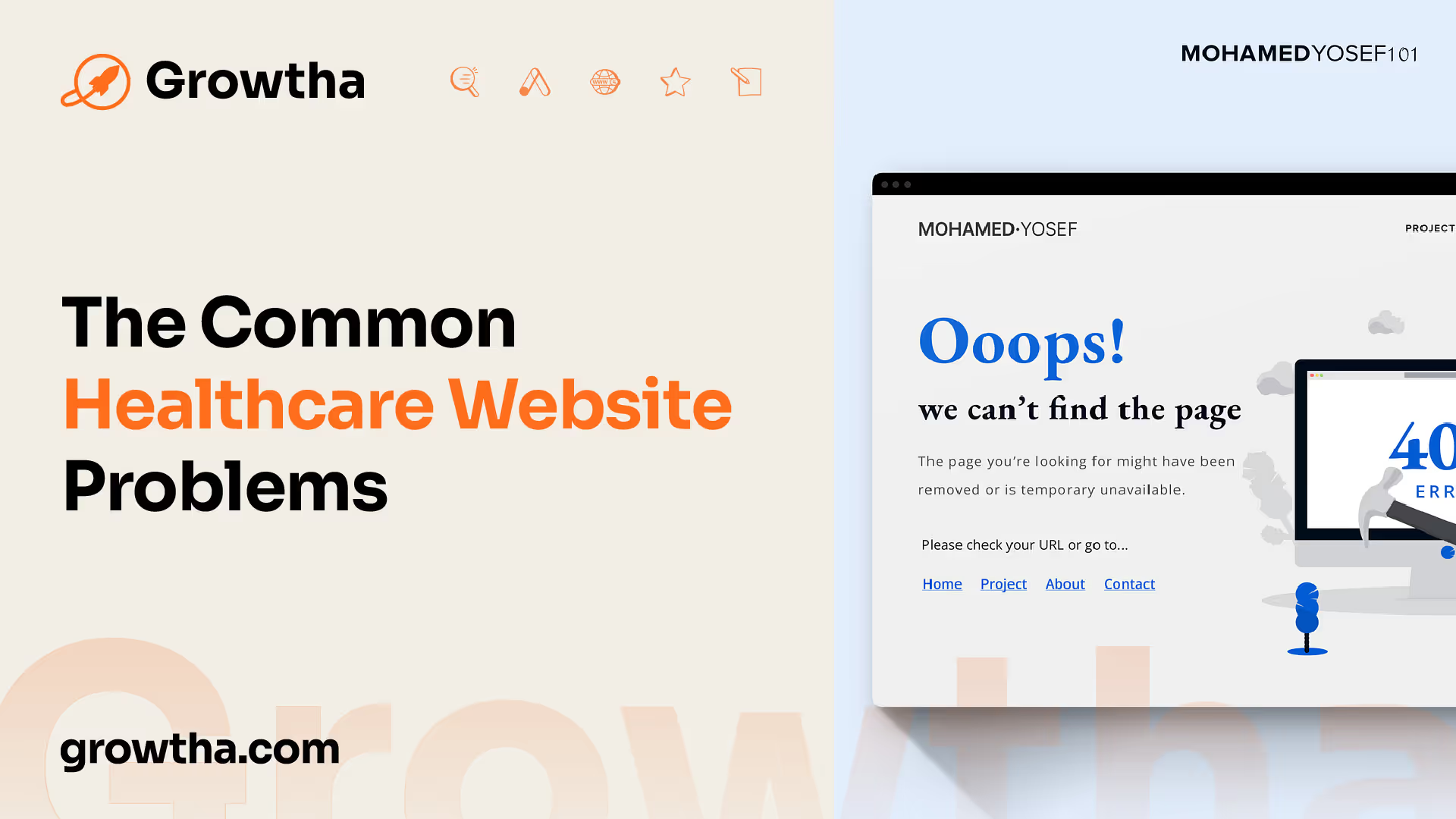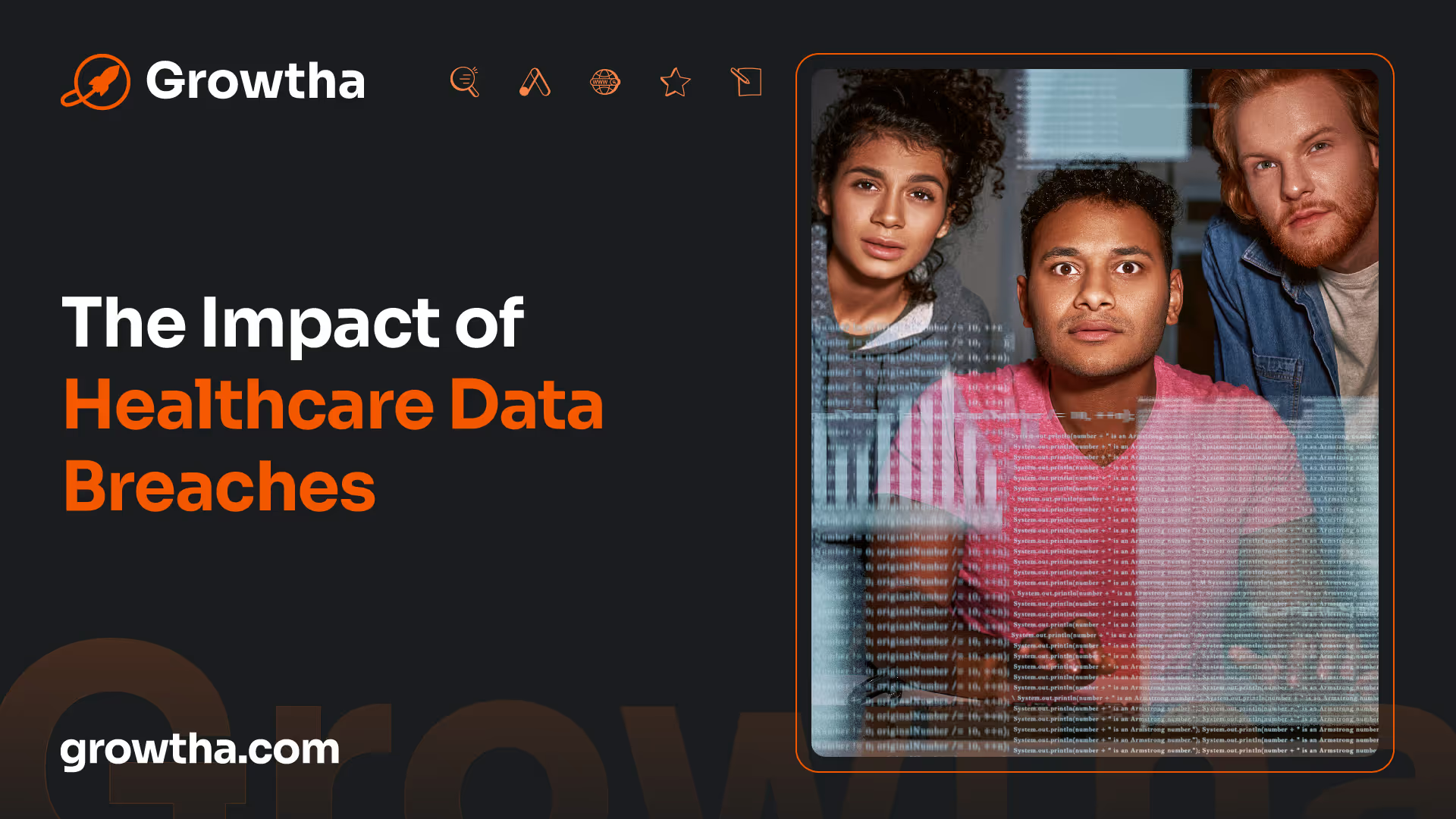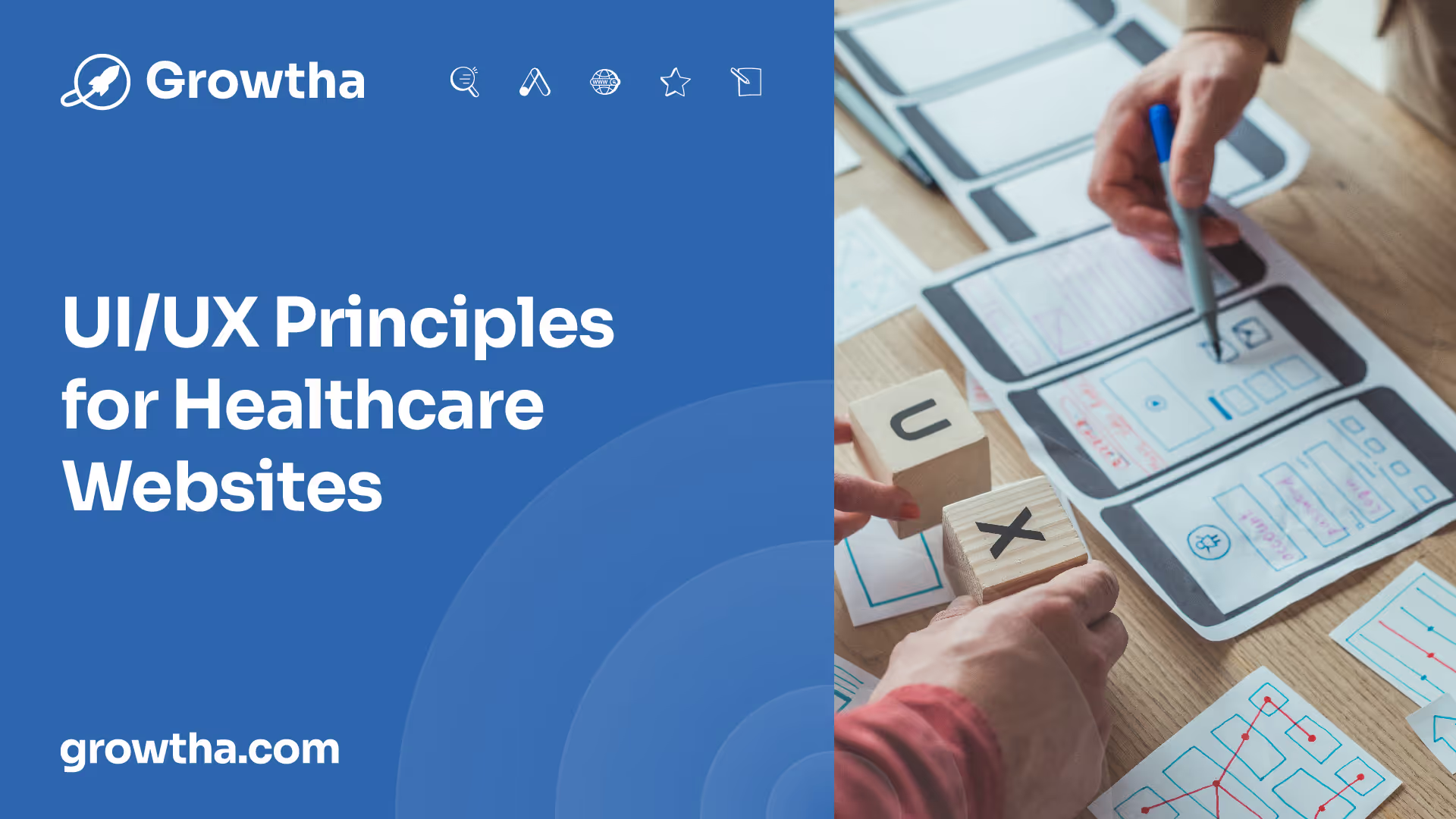The Common Healthcare Website Problems
Healthcare websites play a vital role in providing information, services, and resources to patients and healthcare consumers.


The Common Healthcare Website Problems
Common Healthcare Website Problems
Healthcare websites play a vital role in providing information, services, and resources to patients and healthcare consumers. However, several common problems can undermine the effectiveness and user experience of these websites. Understanding these issues is crucial for improving healthcare website design and optimizing user satisfaction. Here are some of the most prevalent problems faced by healthcare websites:
Privacy and Data Security Issues
Privacy and data security are significant concerns when it comes to healthcare websites. Data breaches, inadequate data encryption, and insufficient compliance with regulations like HIPAA can compromise patient privacy and expose sensitive information. Healthcare websites must prioritize robust security measures to protect patient data and maintain user trust. Ensuring secure data handling practices and implementing stringent privacy protocols are essential steps to address this issue.
Lack of Transparency in Data Handling
A common problem faced by healthcare websites is the lack of transparency in how users' data is collected, used, and protected. This lack of clarity can lead to mistrust among patients and website visitors. To build trust and establish credibility, healthcare websites should provide clear and comprehensive information about data collection practices, data usage, and data protection measures. Transparent communication regarding data handling practices helps to alleviate patient concerns and fosters a sense of confidence in the website's integrity.
Inaccurate and Outdated Information
The accuracy and timeliness of information on healthcare websites are crucial for patients seeking reliable medical resources. However, many healthcare websites struggle with maintaining accurate and up-to-date information on medical services, providers, and facilities. Outdated information can lead to patient confusion and frustration, impacting the credibility and usefulness of the websites. Regular content audits, frequent updates, and effective content management systems are necessary to ensure that healthcare websites provide accurate and current information to their users.
Accessibility Challenges
Ensuring accessibility is an essential aspect of healthcare websites. However, many healthcare websites face challenges in this area. Poor design for users with disabilities and lack of compliance with accessibility standards can exclude individuals with disabilities from accessing vital healthcare information online. Healthcare websites should adhere to accessibility guidelines, such as the Web Content Accessibility Guidelines (WCAG), to make their content and services accessible to all users, regardless of disabilities. By prioritizing accessibility, healthcare websites can expand their reach and provide equal access to healthcare information for everyone.
Poor User Experience and Navigation
User experience (UX) plays a crucial role in the success of any website, including healthcare websites. Many healthcare websites suffer from poor user experience and navigation, making it difficult for patients to find relevant information easily and engage with the content effectively. Cluttered layouts, complex navigation systems, and unintuitive interfaces hinder users' ability to navigate the site and locate the information they need. By adopting user-centered design principles, simplifying navigation, and improving the overall user interface (UI), healthcare websites can enhance user satisfaction and improve engagement with their content [1].
Understanding and addressing these common healthcare website problems is crucial for improving the overall user experience, ensuring data security and privacy, and providing accurate and accessible healthcare information. By prioritizing these areas, healthcare websites can better serve their users and contribute to more effective healthcare communication and delivery.

The Impact of Healthcare Data Breaches
Data breaches in the healthcare industry have far-reaching consequences, affecting both individuals and organizations. Understanding the frequency, financial implications, causes, and concerns surrounding healthcare data breaches is crucial for addressing these significant challenges.
Frequency and Magnitude of Data Breaches
The healthcare industry is among the worst affected by data breaches, with the highest number of breaches compared to other industries. From 2005 to 2019, there were 249.09 million individuals affected by healthcare data breaches. In the last five years alone, 157.40 million individuals were affected [2].
Financial Consequences of Data Breaches
Data breaches pose significant financial risks to the healthcare industry. The average cost of a data breach in the healthcare sector in 2019 was $6.45 million, higher than the average cost in other industries, which was $3.92 million. The average breach size in the healthcare industry was 25,575 records. Over the years, the average cost of a data breach in the healthcare sector has been increasing. From 2014 to 2019, it saw a 19.4% increase, the highest among all industries. The average cost of a breached record in the healthcare sector also increased by 3.4% in the same period.
Causes of Healthcare Data Breaches
Data breaches in the healthcare industry are primarily caused by hacking/IT incidents, followed by unauthorized internal disclosures. These incidents have been increasing rapidly in frequency and magnitude, leading to substantial financial losses. It is crucial for healthcare organizations to invest in robust cybersecurity measures to protect sensitive patient data and prevent unauthorized access.
Concerns Over Privacy and Security
Healthcare data breaches raise significant concerns over privacy and security. When personal health information falls into the wrong hands, individuals may become victims of identity theft, insurance fraud, or other forms of malicious activities. The loss of trust in healthcare organizations due to breaches can have long-lasting consequences. Patients may hesitate to share sensitive information, impacting the quality of care and hindering progress in healthcare research.
Addressing the challenges posed by healthcare data breaches requires a multifaceted approach, including enhanced cybersecurity measures, strict data protection regulations, and increased awareness among healthcare professionals and patients. By prioritizing privacy and security, the healthcare industry can work towards minimizing the impact of data breaches and safeguarding sensitive patient information.

UI/UX Principles for Healthcare Websites
In the realm of healthcare marketing, UI/UX (User Interface/User Experience) principles play a crucial role in designing effective and user-friendly websites. Whether it's an appointment scheduling app or an electronic health record system, UI/UX design for healthcare websites is of utmost importance. Let's explore the key aspects of UI/UX principles in the context of healthcare websites.
Importance of UI/UX Design
UI/UX design focuses on creating a positive and seamless user experience. It emphasizes how users interact with a product or website and how it makes them feel. In the case of healthcare websites, a well-designed UI/UX can enhance user engagement, reinforce credibility, and ultimately improve user satisfaction. By prioritizing UI/UX principles, healthcare websites can create a user-centric environment that encourages visitors to explore the site and find the information they seek.
User Experience (UX) Design
User Experience (UX) design focuses on understanding user behaviors, needs, and expectations when interacting with a website. It aims to create a seamless and intuitive user journey, ensuring that visitors can easily navigate through the website, find relevant information, and accomplish their goals. A well-executed UX design in healthcare websites can improve patient satisfaction, enhance trust, and foster a positive perception of the healthcare provider or organization.
User Interface (UI) Design
User Interface (UI) design deals with the visual aspects and structural elements of a website, such as navigation, buttons, colors, typography, and overall aesthetics. In healthcare website design, UI design plays a vital role in creating an intuitive and visually appealing interface that guides users through their interactions. By employing thoughtful UI design principles, healthcare websites can enhance usability, improve information readability, and create a cohesive and visually pleasing experience for visitors.
UI/UX Basics for Healthcare Websites
To ensure the success of a healthcare website, it is crucial to incorporate UI/UX basics. These principles encompass various elements, including:
- Intuitiveness: The website should be easy to navigate and understand, allowing users to find information quickly.
- User-Friendly Layout: A well-organized and visually balanced layout ensures that visitors can easily locate the desired information without feeling overwhelmed.
- Clear Calls to Action: Prominent and well-designed buttons and links guide users to take specific actions, such as scheduling appointments or accessing patient resources.
- Responsive Design: The website should be optimized for different devices and screen sizes, ensuring a seamless experience across desktops, tablets, and mobile devices.
- Accessible Design: Healthcare websites should adhere to accessibility standards, making the content accessible to individuals with disabilities.
By incorporating these UI/UX basics, healthcare websites can provide a user-friendly experience, instill trust, and effectively communicate important information to visitors.
By implementing UI/UX principles in healthcare website design, healthcare providers and organizations can create an engaging and user-centric online presence. A well-designed website not only enhances the user experience but also reinforces the credibility and trustworthiness of the healthcare provider or organization.
Usability Challenges in Healthcare Websites
Creating a user-friendly and intuitive healthcare website is paramount to ensure a positive user experience. However, there are several common usability challenges that healthcare websites often face. These challenges include cluttered layouts and visual overload, complex navigation systems, slow loading speeds, and accessibility issues.
Cluttered Layouts and Visual Overload
One of the primary usability challenges in healthcare websites is a cluttered layout and visual overload. When a website contains an overwhelming amount of information, it can confuse and overwhelm users, hindering their ability to find the desired information quickly. A cluttered layout can also impact readability and make it challenging for users to focus on essential content.
To address this challenge, healthcare websites should adopt a clean and organized design approach that prioritizes relevant information. Clear visual hierarchy, proper use of whitespace, and concise content can help improve readability and guide users through the website. By decluttering the layout and reducing visual overload, healthcare websites can enhance the user experience and facilitate efficient information retrieval.
Complex Navigation Systems
Complex navigation systems pose a significant usability challenge for healthcare websites. When users struggle to find the information they need due to convoluted navigation, frustration can arise, leading to poor user engagement and decreased satisfaction. Healthcare websites often have extensive content, making it crucial to provide intuitive navigation that allows users to navigate easily.
An effective solution to this challenge is to implement a simplified and intuitive navigation structure. Websites should have clear and concise labels for navigation elements, enabling users to find information quickly. A logical hierarchy, breadcrumb navigation, and search functionality can also enhance the user experience by enabling users to locate specific information efficiently.
Slow Loading Speeds
Slow loading speeds have a detrimental impact on the usability of healthcare websites. Users expect fast-loading websites, and delays can lead to high bounce rates and user frustration. Particularly for mobile users accessing the website on 4G networks, slow loading times can be especially problematic.
To overcome this challenge, healthcare websites should prioritize optimizing their website's loading speed. This can be achieved by compressing images, leveraging browser caching, minimizing unnecessary scripts, and optimizing code. By ensuring swift loading times, healthcare websites can provide a seamless user experience and prevent users from abandoning the site due to slow loading speeds.
Accessibility Issues
Healthcare websites must be accessible to all users, including those with disabilities. However, accessibility issues often pose a significant challenge. Insufficient color contrast, lack of proper alt text for images, and inadequate keyboard navigation options can hinder users with disabilities from effectively accessing and using healthcare websites.
To address accessibility challenges, healthcare websites should adhere to accessibility guidelines, such as the Web Content Accessibility Guidelines (WCAG). This includes providing alt text for images, ensuring proper color contrast, and implementing keyboard navigation options. By prioritizing accessibility, healthcare websites can ensure that all users can access the information they need, promoting inclusivity and equal access to healthcare resources.
Addressing these usability challenges is crucial for healthcare websites to provide a seamless and user-friendly experience. By implementing clean layouts, intuitive navigation, optimizing loading speeds, and ensuring accessibility, healthcare websites can enhance user satisfaction, engagement, and facilitate effective communication of important healthcare information.
Challenges in EHR Systems and Patient Care Delivery
Efficient and effective electronic health record (EHR) systems are crucial for seamless patient care delivery. However, there are several challenges that healthcare websites, particularly those related to EHR systems, face. These challenges can impact the overall quality of patient care and the satisfaction of healthcare professionals. Let's explore some of these challenges in more detail.
Lack of Focus and Cluttered Interfaces
One of the primary challenges in EHR systems and healthcare websites is the lack of focus and cluttered interfaces. Poorly designed interfaces can lead to confusion and hinder patient care delivery. When critical information is not easily accessible or displayed prominently, healthcare professionals may struggle to find the necessary data, resulting in delays and potential errors. It is important for healthcare websites to prioritize the display of critical information and streamline the user interface to enhance usability and efficiency.
Data Entry Errors and Safety Hazards
The design and usability of healthcare websites play a significant role in preventing data entry errors and ensuring patient safety. When websites lack intuitive and user-friendly interfaces, healthcare professionals may inadvertently enter incorrect information, leading to inaccurate patient records and potential safety hazards. It is crucial for healthcare websites to prioritize user-centered design principles, such as clear and logical data entry fields, to minimize the risk of errors and enhance patient safety.
Impact on Physician Burnout and Satisfaction
Inefficient EHR systems and healthcare websites can have a negative impact on healthcare professionals, leading to increased physician burnout and reduced job satisfaction. Complex and cumbersome interfaces can create additional administrative burdens, taking away valuable time that could be spent on patient care. When healthcare professionals struggle with unintuitive systems and excessive documentation requirements, their overall satisfaction and the quality of care they provide may be compromised. It is essential for healthcare websites to prioritize usability and streamline processes to alleviate the burden on healthcare professionals and enhance their satisfaction.
Frustration and Decreased Productivity
Poorly designed healthcare websites can frustrate users, including healthcare professionals, resulting in decreased productivity. Complex navigation systems, slow loading speeds, and other usability issues can hinder the efficiency of healthcare professionals in accessing critical information and performing necessary tasks. When frustration levels are high, healthcare professionals may experience decreased productivity, potentially impacting the quality and timeliness of patient care. It is crucial for healthcare websites to prioritize user experience and ensure that interfaces are intuitive, responsive, and optimized for efficient use.
Addressing these challenges in EHR systems and healthcare websites is essential for improving patient care delivery and enhancing the satisfaction of healthcare professionals. By prioritizing focus, intuitive interfaces, accurate data entry, and user-centered design principles, healthcare websites can contribute to a more efficient and effective healthcare system.
Cybersecurity Challenges in the Healthcare Industry
In today's digital landscape, the healthcare industry faces significant cybersecurity challenges. As technology and digitization continue to play a crucial role in healthcare, the reliance on interconnected medical devices introduces vulnerabilities that cybercriminals can exploit. Let's explore some of the key cybersecurity challenges faced by the healthcare industry.
Interconnected Medical Devices and Vulnerabilities
The healthcare sector heavily relies on a vast array of interconnected medical devices, ranging from patient monitoring systems to imaging equipment. However, this interconnectedness presents security and IT challenges. In many cases, different medical departments purchase and maintain their own devices, leading to a complex network that can be challenging to secure. This fragmentation allows hackers to exploit unpatched devices and gain unauthorized access to healthcare networks, potentially resulting in data breaches and even the shutdown of critical hospital systems.
Shortage of Cybersecurity Professionals
The shortage of cybersecurity professionals in the healthcare industry poses a significant challenge. With limited resources to hire professionals for round-the-clock monitoring, detection, and response to cyber threats, healthcare organizations face increased vulnerability. Without a dedicated team of cybersecurity experts, it becomes challenging to prevent, detect, and mitigate cyber-attacks effectively.
Major Cyber Threats in Healthcare
The healthcare sector encounters a variety of cyber threats that can have severe consequences. Some of the major threats include:
- Ransomware Attacks: These attacks involve encrypting sensitive data and demanding a ransom for its release. Hospitals and healthcare organizations have become prime targets for ransomware attacks, disrupting patient care and potentially compromising confidential information.
- Phishing: Phishing attempts through deceptive emails or websites aim to trick healthcare professionals into revealing sensitive information or providing access to healthcare systems.
- Distributed Denial of Service (DDoS): DDoS attacks overload networks or websites, rendering them inaccessible to users. Such attacks can disrupt critical healthcare services and cause significant financial losses.
- Botnets: Cybercriminals utilize botnets to coordinate attacks on healthcare systems, exploiting vulnerabilities and gaining unauthorized access.
- Insider Threats: Internal employees or contractors with access to healthcare systems can intentionally or unintentionally compromise data security, leading to breaches or unauthorized access.
Exploiting Vulnerabilities in Legacy Systems
Legacy systems, lack of resources, interconnected systems, and data sharing and privacy issues create vulnerabilities that cybercriminals can exploit. Outdated software and hardware may lack necessary security updates, making them more susceptible to attacks. Additionally, the interconnected nature of healthcare systems and the sharing of sensitive information increase the potential attack surface for cybercriminals [5].
To combat these cybersecurity challenges, healthcare organizations must prioritize investing in robust security measures, hiring skilled professionals, implementing comprehensive training programs, and regularly updating and patching their systems. By adopting proactive cybersecurity measures, the healthcare industry can better protect sensitive patient data, maintain the integrity of healthcare services, and safeguard against potential cyber threats.
Importance of Page Loading Speed for Healthcare Websites
When it comes to healthcare websites, page loading speed is a critical factor that significantly impacts user experience and website performance. In this section, we will explore the importance of fast page loading speed and its various implications.
Impact on User Satisfaction and Bounce Rates
Studies have shown that page loading speed plays a crucial role in determining user satisfaction with a website's mobile experience. Slow loading speeds can lead to frustration and a negative overall perception of the website. If users encounter delays while waiting for a page to load, they are more likely to leave the site and seek alternatives that provide a faster and smoother experience.
Abandonment Due to Slow Loading Speeds
Research has found that website visitors have little patience when it comes to slow-loading websites. If a website takes longer than three seconds to load, the majority of users are more likely to abandon it and move on to a faster alternative. This high bounce rate negatively impacts website engagement and conversions. It is crucial for healthcare websites to prioritize fast loading speeds to retain users and keep them engaged.
Positive User Experience and Attracting Visitors
Having a fast-loading website is essential for providing a positive user experience. A slow-loading website can hinder the ability to quickly find important information or even book appointments online. On the other hand, a fast website enhances usability, allowing users to navigate seamlessly, access information efficiently, and complete desired actions with ease. By prioritizing page loading speed, healthcare websites can attract more visitors and retain their interest.
SEO Benefits of Fast-Loading Websites
In addition to enhancing user experience, fast-loading websites also receive SEO benefits. Search engines like Google prioritize fast-loading websites in their search algorithm updates. Websites that provide a seamless user experience through faster load times are rewarded with higher rankings. This means that healthcare websites with fast loading speeds have a better chance of ranking higher in search engine results, increasing their visibility and attracting more organic traffic.
It is evident that page loading speed is a crucial aspect of healthcare websites. By ensuring fast loading times, healthcare organizations can enhance user satisfaction, reduce bounce rates, attract more visitors, and improve their overall online presence. Prioritizing page loading speed is essential for providing a seamless user experience and maximizing the potential of a healthcare website.
References
[1]: https://resources.observepoint.com/blog/healthcare-websites-privacy-issues/
[2]: https://www.ncbi.nlm.nih.gov/pmc/articles/PMC7349636/
[3]: https://www.linkedin.com/pulse/10-uiux-tips-healthcare-website-patients-love-oleh-pylyp
[4]: https://www.ama-assn.org/practice-management/digital/7-ehr-usability-safety-challenges-and-how-overcome-them
[5]: https://www.linkedin.com/pulse/healthcare-industry-current-cyber-threats-vulnerabilities-7yltf
[6]: https://www.sapidseocompany.com/seo-services/industries/medical-seo/importance-of-page-loading-speed-for-hospital-websites/







